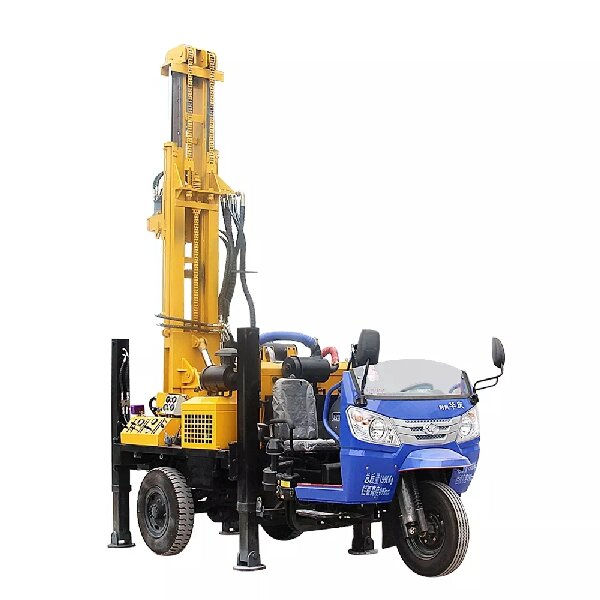How to handle encountering a cavern with a small water well drilling rig
When you are using a small water well Drilling Rig and you hit a cavern, it can get a little tricky, but there are definitely ways to deal with it. Here's the lowdown on what might happen and how to handle it:
Things That Could Go Wrong:
The drill suddenly feels light and drops: When the drill bit punches into a cavern, there's suddenly nothing underneath, so the drill pipe might just take a nosedive.
The hole goes sideways: The drill bit might slide along the edges or bumpy parts of the cavern, and your hole ends up going in the wrong direction.
The hole caves in and the drill gets stuck: If the rock around the cavern isn't solid, it could collapse, and your drill pipe could get jammed tight.
You lose a ton of drilling mud: If the cavern is big or has lots of cracks, your drilling fluid might just disappear into it, making it hard to keep things circulating.
Groundwater could vanish or get messed up: If the cavern is connected to where the water is, you could lose your water, or water from different layers could mix together.

How to Handle It:
1. Try to See It Coming:
Check the Dirt Info: Before you even start drilling, try to find out what the ground is like in that area. See if there is a chance of hitting any caverns.
Use Underground Scanners: You can use special tools like ground-penetrating radar or electrical surveys to get a peek underground and see if there are any empty spaces.
Look at Other Wells Nearby: If there are already wells in the area, check their drilling records to see if they ran into any caverns and how deep they were.
2. Keep an Ear and Eye Out While Drilling:
Watch the Pressure and Speed: Pay close attention to the pressure gauge and how fast you are drilling. If they suddenly drop or jump up, it could mean you've hit a cavern.
Check the Mud Flow: See how much drilling fluid is coming back up and what it looks like. If you suddenly lose a lot of it, it might be draining into a cavern.
Listen to the Drill: Pay attention to the sound of the drill. If it starts making weird hollow noises or vibrating strangely, the drill bit might have entered an empty space.
3. What to Do When You Hit a Cavern:
Hold Steady and Slow Down: As soon as you think you've hit a cavern, hold the drill pipe steady and slow down how fast you are lowering it. You don't want it to crash down and get damaged or stuck.
Note the Depth and Size: Write down exactly how deep you were when you hit the cavern, how much further you drilled through it (to guess its size), and what was inside if you could tell.
Different Situations, Different Fixes:
Small and Solid Cavern: If the cavern isn't too big and the rock around it seems stable, you can probably just drill through it slowly and keep going. Just keep an eye on whether the hole is starting to go sideways.
Big or Unstable Cavern:
Reinforce the Walls: You might need to put in casing (pipes) or pump in cement grout to strengthen the walls of the hole around the cavern and stop it from collapsing or losing fluid.
Fill It Up: If the cavern is huge and making it hard to keep drilling, you might have to fill it in with things like gravel, crushed rock, or cement grout.
Go Around It: If you can, try changing the direction you are drilling to go around the cavern and find more solid ground.
Special Drilling Tricks: In areas known for caverns, you might need to use special drilling methods, like drilling with a casing right behind the drill bit, to keep the hole stable.
Dealing with Lost Mud:
Thicken the Mud: Make your drilling fluid thicker and heavier to help it plug up cracks and holes better.
Add Lost Circulation Material: Put special stuff (like clay, fibers, or small particles) into the drilling fluid to block off the cracks and holes in the cavern and stop the leaks.
Pump and Wait: Try pumping the drilling fluid for a bit, then stopping and letting it sit for a while. This gives the plugging material time to seal up the leaks.
4. What to Do Afterwards:
Keep Good Records: No matter how you dealt with the cavern, write down everything about it, what you did, and how it worked out. This will help with any future drilling or setting up the well.
Make Sure the Well is Good: When you are finishing the well in an area with caverns, pay extra attention to making sure the walls of the well are stable and sealed properly. This will make sure your well lasts and the water is safe.

If you want to know more about small water well drilling rig, please click the link to contact us and we will introduce you more relevant knowledge
small water well drilling rig

